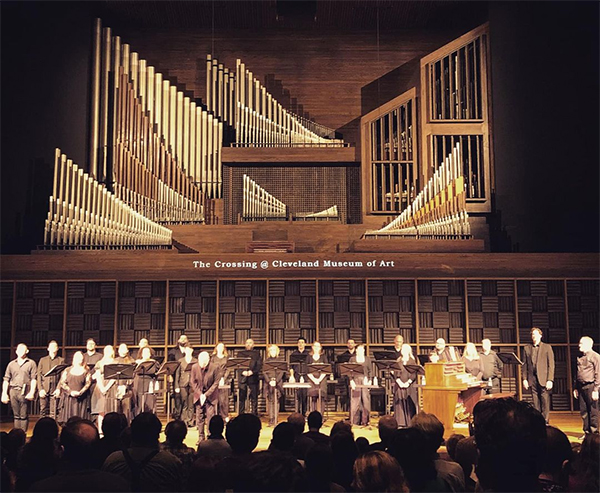by Peter Feher

From conception to instrumentation, the score was crafted with CMA in mind. The performance (brought together by the museum’s director of performing arts, Tom Welsh) honored the late Robert G. Schneider, combining the two musical passions of that Cleveland choir director and organist. In fact, Friday’s entire program, which featured the Philadelphia-based chamber choir The Crossing, made the most of Gartner Auditorium’s organ.
Listeners immediately got a sense of that choir-organ pairing from the concert’s opening pieces. Lansing D. McLoskey’s The Memory of Rain had the vocalists sustaining dissonances with an insistence that matched the keyboard instrument. The clashes went well beyond harmony, from lines of text broken up and delivered every other word by alternating groups of singers, to a section in the third movement where at least three separate time signatures were happening at once. Conductor Donald Nally and his ensemble were entirely at home with these contemporary challenges.
Arvo Pärt’s setting of Salve Regina calls for a balanced, rather than clashing, whole. Organist Scott Dettra kept up a flowing accompaniment from which the vocals could fade in and out. The gentleness of the work gives way to a couple of big, magisterial moments, which let The Crossing and Dettra open up to an impressive “glory of God” sound — a reminder of where one is most likely to hear organ and singing together.
With the possibilities of the ensemble established, Garrop’s premiere on the second half asked for everything and more. Her piece, which sets a selection of very short stories by Lydia Davis on themes of memory and aging, unfolds in five movements, plus prologue, epilogue, and interludes. It made for an engaging and dramatic 30 minutes.
The fragments of words and phrases that begin the work (and return with each interlude) provide an effective framing for Davis’ stories to emerge. Incomplete thoughts transform into fully formed sentences that the music then complements.
Garrop translated the danger of the first story, “A Natural Disaster,” into an engulfing organ part that threatens to subsume the entire choir. The piece’s namesake movement, “In a House Besieged,” shares this beleaguered perspective and receives a similar musical treatment.
The composer made an inspired choice in adapting “The Cottages,” enhancing Davis’ story with wordless singing imagined for one of its characters. Less successful are settings of two psychologically taut stories, which play up the thriller-ish element in an organ part that borders on spooky Halloween.
The music drops away in the end: the final lines, which complete the fragments first introduced in the prologue, are spoken by the choir. After so much musical development, the work arrives at a literary conclusion, suggesting that it’s ultimately the precision of a thought that remains.
Published on ClevelandClassical.com March 30, 2022.
Click here for a printable copy of this article



